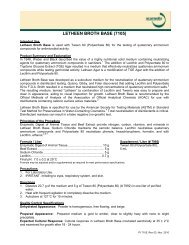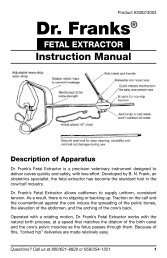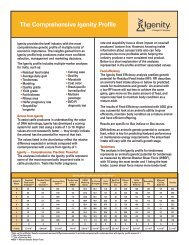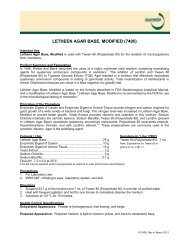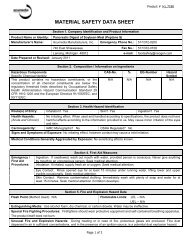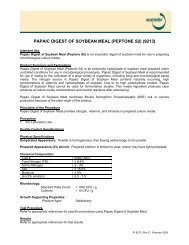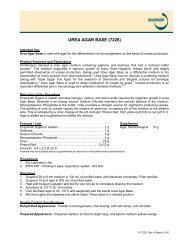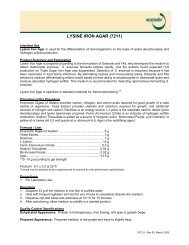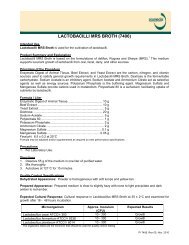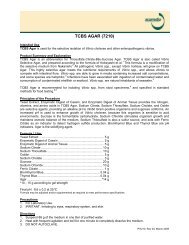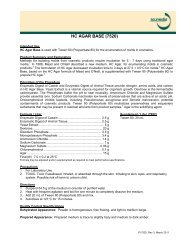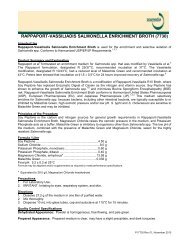Baird Parker Agar — 7112
Baird Parker Agar — 7112
Baird Parker Agar — 7112
You also want an ePaper? Increase the reach of your titles
YUMPU automatically turns print PDFs into web optimized ePapers that Google loves.
BAIRD PARKER AGAR (<strong>7112</strong>)<br />
Intended Use<br />
<strong>Baird</strong> <strong>Parker</strong> <strong>Agar</strong> is used for detection and enumeration of Staphylococcus aureus in foods.<br />
Product Summary and Explanation<br />
<strong>Baird</strong> <strong>Parker</strong> <strong>Agar</strong> was first described in 1962. 1 It is a selective medium for the isolation and presumptive<br />
identification of coagulase-positive staphylococci. This medium is used extensively for detecting<br />
Staphylococcus aureus in foods, dairy products, and other materials. 2-6 Coagulase-positive staphylococci can<br />
grow and reproduce in cosmetic products. These products are tested for the presence of coagulase-positive<br />
staphylococci using standard microbiological methods. 4<br />
Principles of the Procedure<br />
Enzymatic Digest of Casein and Beef Extract are the carbon and nitrogen sources in <strong>Baird</strong> <strong>Parker</strong> <strong>Agar</strong>.<br />
Yeast Extract supplies B-complex vitamins that stimulate bacterial growth. Glycine and Sodium Pyruvate<br />
stimulate growth of staphylococci. The selectivity of the medium is due to Lithium Chloride and a 1%<br />
Potassium Tellurite Solution, suppressing growth of organisms other than staphylococci. The differentiation of<br />
coagulase-positive staphylococci is based on Potassium Tellurite and Egg Yolk Emulsion. Staphylococci that<br />
contain lecithinase break down the Egg Yolk and cause clear zones around the colonies. An opaque zone of<br />
precipitation may form due to lipase activity. Reduction of Potassium Tellurite is a characteristic of coagulasepositive<br />
staphylococci, and causes blackening of colonies. <strong>Agar</strong> is the solidifying agent.<br />
Formula / Liter Enrichment (# 7983)<br />
Enzymatic Digest of Casein .................................................... 10 g Egg Yolk Tellurite, 100 mL<br />
Beef Extract. ............................................................................. 5 g (Chicken egg yolk and egg, 100%)<br />
Yeast Extract ............................................................................. 1 g (Potassium Tellurite, 0.21 g)<br />
Lithium Chloride ........................................................................ 5 g<br />
Glycine .................................................................................... 12 g Enrichments (# 7982 & # 7989)<br />
Sodium Pyruvate ..................................................................... 10 g Chicken egg yolk & egg, 50% (# 7982)<br />
<strong>Agar</strong> ....................................................................................... *17 g Tellurite Supplement (1%) (# 7989)<br />
*15 - 20 g according to gel strength<br />
Final pH: 7.0 ± 0.2 at 25°C<br />
Formula may be adjusted and/or supplemented as required to meet performance specifications.<br />
Precautions<br />
1. For Laboratory Use.<br />
2. HARMFUL. Harmful if swallowed, inhaled, or absorbed through skin. Skin irritation may be severe.<br />
Irritating to eyes, respiratory system, and skin. May cause central nervous system effects.<br />
Directions<br />
1. Suspend 60 g of the medium in one liter of purified water.<br />
2. Heat with frequent agitation and boil for one minute to completely dissolve the medium.<br />
3. Autoclave at 121°C for 15 minutes.<br />
4. After cooling to 45 - 50°C, add 50 mL of Egg Yolk Tellurite Supplement (# 7983). Alternatively, add 50 mL<br />
of Egg Yolk Emulsion (# 7982) and 10 mL of Tellurite Supplement (1%), (# 7989).<br />
5. Mix thoroughly before dispensing.<br />
Quality Control Specifications<br />
Dehydrated Appearance: Powder is homogeneous, free flowing, and beige.<br />
Prepared Appearance (Plain): Prepared medium is trace to slightly hazy and light amber.<br />
PI <strong>7112</strong> Rev 6, March 2012
Prepared Appearance (with Egg Yolk Tellurite Supplement): Prepared medium is canary yellow and<br />
opaque.<br />
Expected Cultural Response: Cultural response on <strong>Baird</strong> <strong>Parker</strong> <strong>Agar</strong> with Egg Yolk Tellurite Supplement<br />
(# 7983) at 35 ± 2°C after 24 - 48 hours incubation in anaerobic atmosphere.<br />
Microorganism Approx.<br />
Expected Results<br />
Inoculum (CFU) Growth Reaction<br />
Enterococcus faecalis ATCC 29212 10 - 300 Poor to fair Black colonies suppressed,<br />
no halo<br />
Escherichia coli ATCC® 25922 10 3 Inhibited ------<br />
Proteus mirabilis ATCC® 12453 10 - 300 Partially inhibited Black colonies, no halo<br />
Staphylococcus aureus ATCC 25923 10 - 300 Fair to good Black colonies with a clear<br />
halo<br />
Staphylococcus epidermidis ATCC 12228 10 - 300 Poor Grey to Black colonies,<br />
suppressed, no halo<br />
The organisms listed are the minimum that should be used for quality control testing.<br />
Test Procedure<br />
1. Prepare dilutions of test samples, if indicated by references. 2-5<br />
2. Transfer 1 mL of the sample to each of 3 <strong>Baird</strong> <strong>Parker</strong> <strong>Agar</strong> plates, distribute over the surface using a<br />
sterile, bent glass rod.<br />
3. Allow inoculum to be absorbed by the medium before inverting the plates.<br />
4. Incubate at 35 - 37°C for 45 - 48 hours.<br />
5. Examine plates having 20 - 200 colonies, counting colonies typical of Staphylococcus aureus.<br />
Results<br />
Coagulase-positive staphylococci produce black, shiny, convex colonies with entire margins and clear zones,<br />
with or without an opaque zone. Coagulase-negative staphylococci produce poor or no growth. If growth<br />
occurs, colonies are black; clear or opaque zones are rare. The majority of other organisms are inhibited or<br />
grow poorly. If growth appears, colonies are light to brown-black, with no clear or opaque zones.<br />
Storage<br />
Store sealed bottle containing the dehydrated medium at 2 - 30°C. Once opened and recapped, place the<br />
container in a low humidity environment at the same storage temperature. Protect from moisture and light by<br />
keeping container tightly closed.<br />
Expiration<br />
Refer to expiration date stamped on the container. The dehydrated medium should be discarded if not free<br />
flowing, or if the appearance has changed from the original color. Expiry applies to medium in its intact<br />
container when stored as directed.<br />
Limitation of the Procedure<br />
Due to nutritional variation, some strains may grow poorly or fail to grow on this medium.<br />
Packaging<br />
<strong>Baird</strong> <strong>Parker</strong> <strong>Agar</strong> Code No. <strong>7112</strong>A 500 g<br />
<strong>7112</strong>B 2 kg<br />
<strong>7112</strong>C 10 kg<br />
Egg Yolk Tellurite 7983 100 mL<br />
Egg Yolk Emulsion 7982 100 mL<br />
Tellurite Supplement (1%) Chapman 7989 10 mL<br />
PI <strong>7112</strong> Rev 6, March 2012
References<br />
1. <strong>Baird</strong>-<strong>Parker</strong>, A. C. 1962. An improved diagnostic and selective medium for isolating coagulase-positive staphylococci. J. Appl.<br />
Bacteriol. 25:12-19.<br />
2. Vanderzant, C., and D. F. Splittstoesser (eds.). 1992. Compendium of methods for the microbiological examination of food. 3 rd<br />
ed. American Public Health Association, Washington, D.C.<br />
3. Marshall, R. T. (ed.). 1993. Standard methods for the microbiological examination of dairy products, 16 th ed. American Public<br />
Health Association, Washington, D.C.<br />
4. www.fda.gov/Food/ScienceResearch/LaboratoryMethods/BacteriologicalAnalyticalmanualBAM/default.htm.<br />
5. Cunnif, P. (ed.). 1995. Official Methods of Analysis AOAC International, 16 th ed. AOAC International, Gaithersburg, MD.<br />
6. United States Pharmacopeial Convention. 2007. The United States pharmacopeia, 31 st ed., Amended Chapters 61, 62, 111.<br />
The United States Pharmacopeial Convention, Rockville, MD.<br />
Technical Information<br />
Contact Acumedia Manufacturers, Inc. for Technical Service or questions involving dehydrated culture media preparation or<br />
performance at (517)372-9200 or fax us at (517)372-2006.<br />
PI <strong>7112</strong> Rev 6, March 2012



